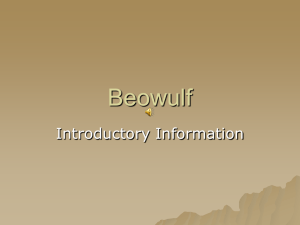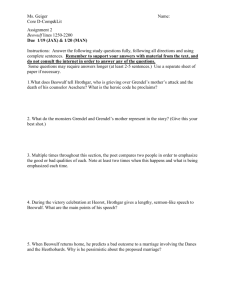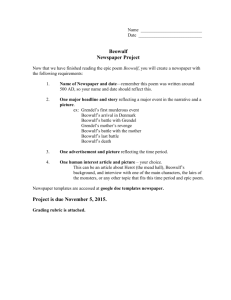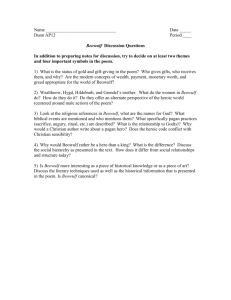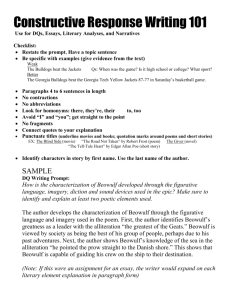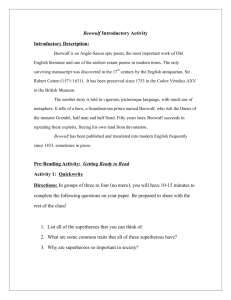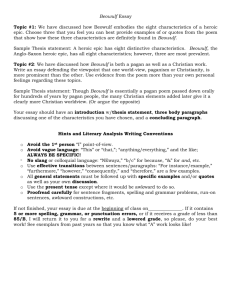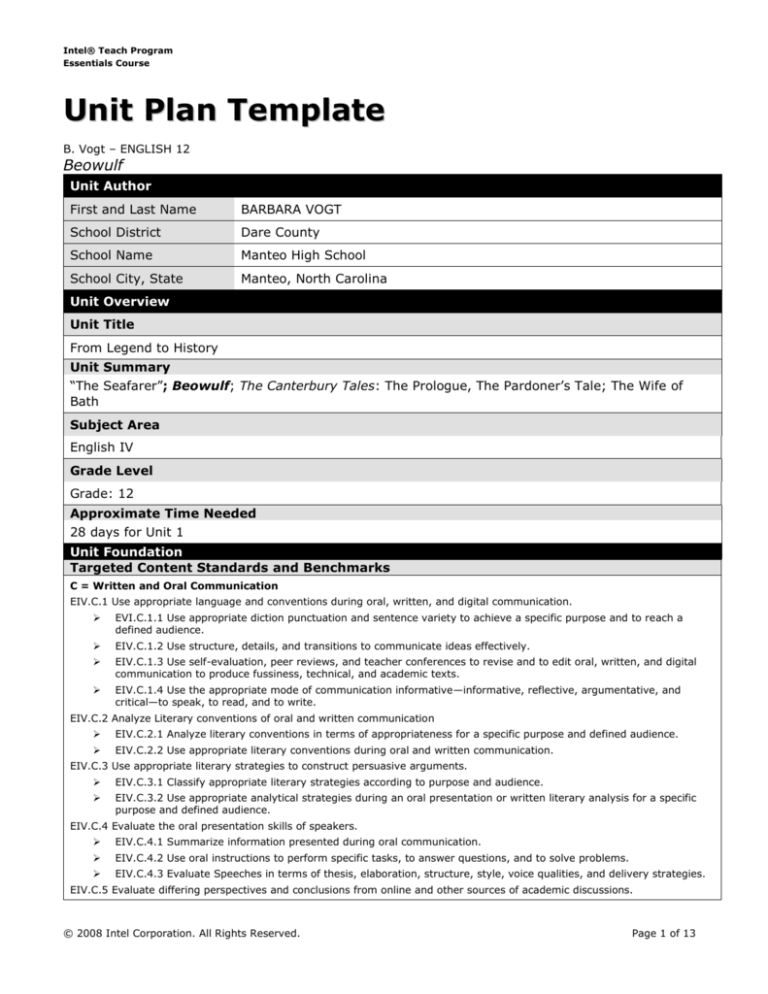
Intel® Teach Program
Essentials Course
Unit Plan Template
B. Vogt – ENGLISH 12
Beowulf
Unit Author
First and Last Name
BARBARA VOGT
School District
Dare County
School Name
Manteo High School
School City, State
Manteo, North Carolina
Unit Overview
Unit Title
From Legend to History
Unit Summary
“The Seafarer”; Beowulf; The Canterbury Tales: The Prologue, The Pardoner’s Tale; The Wife of
Bath
Subject Area
English IV
Grade Level
Grade: 12
Approximate Time Needed
28 days for Unit 1
Unit Foundation
Targeted Content Standards and Benchmarks
C = Written and Oral Communication
EIV.C.1 Use appropriate language and conventions during oral, written, and digital communication.
EVI.C.1.1 Use appropriate diction punctuation and sentence variety to achieve a specific purpose and to reach a
defined audience.
EIV.C.1.2 Use structure, details, and transitions to communicate ideas effectively.
EIV.C.1.3 Use self-evaluation, peer reviews, and teacher conferences to revise and to edit oral, written, and digital
communication to produce fussiness, technical, and academic texts.
EIV.C.1.4 Use the appropriate mode of communication informative—informative, reflective, argumentative, and
critical—to speak, to read, and to write.
EIV.C.2 Analyze Literary conventions of oral and written communication
EIV.C.2.1 Analyze literary conventions in terms of appropriateness for a specific purpose and defined audience.
EIV.C.2.2 Use appropriate literary conventions during oral and written communication.
EIV.C.3 Use appropriate literary strategies to construct persuasive arguments.
EIV.C.3.1 Classify appropriate literary strategies according to purpose and audience.
EIV.C.3.2 Use appropriate analytical strategies during an oral presentation or written literary analysis for a specific
purpose and defined audience.
EIV.C.4 Evaluate the oral presentation skills of speakers.
EIV.C.4.1 Summarize information presented during oral communication.
EIV.C.4.2 Use oral instructions to perform specific tasks, to answer questions, and to solve problems.
EIV.C.4.3 Evaluate Speeches in terms of thesis, elaboration, structure, style, voice qualities, and delivery strategies.
EIV.C.5 Evaluate differing perspectives and conclusions from online and other sources of academic discussions.
© 2008 Intel Corporation. All Rights Reserved.
Page 1 of 13
Intel® Teach Program
Essentials Course
EIV.C.5.1 Use various technologies, such as blogs or other online collaborative tools, to conduct academic discussions
addressing different perspectives and conclusions.
EIV.C.5.2 Evaluate online and other sources of academic discussions according to their different perspective and
conclusions.
EIV.C.6 Create persuasive multimodal small group presentation about global issues.
EIV.C.6.1 Evaluate historical documents, British literature, and nonfiction as sources for persuading a global audience
regarding a specific purpose within a defined content.
EIV.C.6.2 Produce a multimodal small group presentation to persuade a global audience to understand divergent
perspectives about a global issue.
L = Language and Meaning
EIV.L.1 Analyze language for meaning, structure, conventions, and literary techniques
EIV.1.1 Differentiate between contextual word meaning and denotative meaning
EIV.L.1.2 Classify sentences according to their structure, type, conventions, and literary techniques.
EIV.L.1.3 Use language to compose communication for a specific purpose, audience, and context.
EIV.L.2 Use appropriate print and digital sources to determine meaning, pronunciation, word origin, spelling, and usage of
words.
EIV.I.2.1 Understand how to use etymology, linguistic features (including roots, affixes, and cognates), and
contextual clues to determine word meaning and usage.
EIV.I.2.2 Understand common idiomatic expressions, allusions, and nuances in language and word meaning.
EIV.L.2.3 Use common idiomatic expressions, allusions, and nuances appropriately when speaking and writing within
the informative, reflective, argumentative, and critical modes of communication.
EIV.I.3 Evaluate written, visual, and digital texts for the meaning of language, points of view, and internal references
EIV.L.3.1 Understand how to retrieve written, visual and digital texts with literary, abstract, or real life ideas
EIV.L.3.2 Use literary, abstract, or real life ideas to create written, visual and digital texts.
EIV.L.3.3 Evaluate written, visual, and digital texts on the basis of the interpretation of objective language, rational
points of view, and scholarly references.
EIV.L.4 Analyze satire in texts for purpose and audience.
EIV.L.4.1 Contrast humor, parody, sarcasm, and satire in British literature, nonfiction, visual, and digital texts.
EIV.L.4.2 Analyze satirical texts in terms of combined purpose, audience, and stated and inferred meanings.
EIV.L.4.3 Use satire to communicate ideas for a specific purpose and audience.
T = Critical Thinking
EIV.T.1 Analyze oral, written, and digital texts from British literature, nonfiction, and visual sources using the classical appeals
of logos, pathos, and ethos.
EIV.T.1.1 Analyze selected passages in oral, written, and digital texts from British literature, nonfiction, and visual
sources in terms of the primary characteristics of logos, pathos, and ethos.
EIV.T.1.2 Use the classical appeals of logos, pathos, and ethos to communicate ideas for a specific purpose and
audience.
EIV.T.2 Evaluate British literature, nonfiction, and visual texts in terms of their complexity and their ability to inform, to
persuade, and to entertain.
EIV.T.2.1 Analyze the complexity of ideas, diction, syntax, themes, figurative and rhetorical language, organizational
structure, and visual features in selected passages from British literature, nonfiction, and visual texts.
EIV.T.2.2 Evaluate, aural, visual, and written images and other special effects as tools for informing, persuading, and
entertaining.
EIV.T.3 Analyze a variety of British literature and nonfiction texts for themes of the human experience within the context of
global perspectives and historical and current events.
EIV.T.3.1 Understand human experiences in British literature, nonfiction, visual, and digital texts within the context of
global perspectives and historical and current events.
EIV.T.3.2 Analyze British literature, nonfiction, visual, and digital texts in terms of global perspectives and human
experiences, both historical and current.
EIV.T.4 Evaluate solutions to literary and real life problems from British literature and nonfiction texts.
EIV.T.4.1 Evaluate solutions to literary and real life problems from British literature and nonfiction texts to distinguish
among facts, opinions, evidence, inferences, logical fallacies, derogatory language, and faulty reasoning.
EIV.T.4.2 Use literary and real life problems to create appropriate solutions.
R = Research
EIV.R.1 Produce extended researched arguments using primary and secondary sources, visuals and appropriate citation style.
© 2008 Intel Corporation. All Rights Reserved.
Page 2 of 13
Intel® Teach Program
Essentials Course
EIV.R.1.1 Plan an extended researched argument using a writing process that includes barious forms of media
resources, research notes, and graphic organization.
EIV.R.1.2 Understand how to retrieve online and other sources of academic discussions containing different
perspectives and conclusions.
EIV.R.1.3 Use increasingly sophisticated strategies, such as quantitative, technical, and mathematical approaches to
information, to specify details in support of generalizations.
EIV.R.1.4 Use appropriate oral, written and digital communication to understand and to use information in maps,
charts, graphs, timelines, tables, diagrams, advertisements, political cartoons, photographs, and paintings.
EIV.R1.5 Produce an extended researched argument using primary and secondary sources, visuals, and appropriate
citation style.
EIV.R.2 Produce multimodal presentations based on global issues contained in literary, nonfiction, or digital texts.
EIV.R.2.1 Analyze literary, nonfiction, or digital texts using critical thinking, research methods, appropriate modes of
communication, and appropriate citation style.
EIV.R.2.2 Produce multimodal presentations as reflections of academic and personal inquiry, using multiple research
methods, specialized reference texts, primary and secondary sources, and appropriate citation style
Student Objectives/Learning Outcomes
Overview for all of Unit 1
NC WL.1.02.5, CT.4.03.7, LT.5.01.1, LT.5.03.10, LT.5.03.1, GU.6.01.1, GU.6.01.5
Connections: NC WL.1.03.10
Analyze Literary Period: NC CT.4.03.7, LT.5.01.2
Autobiographical Narrative: NC WL.1.01.3, GU.6.01.4
Sequential Order: NC LT.5.03.2, LT.5.03.4
Delivering Autobiographical Presentation: NC GU.6.01.4
Pages 34 - 35
LT.5.02 Relate style, meaning and genre in works of British literature.
LT.5.03.9 Analyze and evaluate effects of author’s craft and style.
Pages 36a – 67
WL.1.02.3 Give written responses that encourage audiences to consider cultural/historical influences on text.
WL.1.03.4 Show understanding of main ideas and supporting details.
W.1.03.5 summarize key textual events
LT.5.03.5 Summarize key events and points.
LT.5.03.6 Infer, predict, and draw conclusions from text.
GU.6.01.2 Understand use and application of grammatical metaphorical, and rhetorical devices.
Preview Workshop selections and activate prior knowledge, relating them to Anchor background key concepts.
Learn and practice vocabulary. Generate examples to reinforce meaning.
Identify the elements of an epic poem including setting, character, plot, and theme.
Practice sorting story elements into a graphic organizer.
Practice analyzing the setting, characters, and elements of an epic poem.
Use text marking to identify poetic elements.
Practice tracking epic poetic elements using a graphic organizer.
Review strategies for reading for detail.
Discussing concept of the hero in Anglo-Saxon times and today.
Compare the many reference to fate or destiny (the Old English word for this force was Wyrd fom which our Modern
English weird) is derived with references to God’s influence.
Complete a Skills Check to demonstrate understanding of poetic elements.
Identify the mood of a poem.
Use text marking to identify words that reflect the mood
Find symbolism within a poem.
Identify imagery in an epic poem. Use text marking to indicate examples of imagery. Practice identifying symbolism
© 2008 Intel Corporation. All Rights Reserved.
Page 3 of 13
Intel® Teach Program
Essentials Course
in a poem.
Review and use Target Words in new contexts, using the words expressively in discussion and in writing. Practice
word-study strategies: verb endings, word families.
Identify the topic, supporting details, and conclusion in a literature response.
Identify the form, audience, and purpose for writing.
Brainstorm ideas for writing using a graphic organizer.
Generate appropriate word Choices to respond to a writing prompt.
Plan a literature response using a graphic organizer
Write a first draft of a literature response.
Use a rubric to assess and then revise writing.
Write an autobiographical narrative.
Delivering Autobiographical Presentations
Analyze Literary Periods.
Recognize complete sentences; identify and correct run-on sentences.
Identify and use correct word order.
Edit draft to correct specific spelling, grammar, and usage errors.
Proofread a writing sample for specific spelling, grammar and usage errors.
Read biographical information.
Practice test-taking strategies: restating the question.
Demonstrate understanding of text selection, vocabulary, and skills.
Practice on-demand writing by responding to a short answer prompt.
Curriculum-Framing Questions
Essential
Question
What happens in an epic poem including the problem, the events that lead to
solving the problem, and the solution.
Setting a Purpose for Reading: Why does Grendel attack the Danes; Why
does Beowulf assist the Danes; what happens in the battles with Grendel,
Grendel’s mother, and the dragon; and for whom is the funeral fire arranged
© 2008 Intel Corporation. All Rights Reserved.
Page 4 of 13
Intel® Teach Program
Essentials Course
Unit
Questions
1. Is Beowulf an epic? What sort of social order produces “epic” poetry?
What values does the poem promote, and how does it promote them?
What sorts of conflicts with or resistances to the ideology of epic can be
expressed? What sorts are found within the poem itself?
2. Look at the religious references in the poem: what are the names for
God? What biblical events are mentioned, and who mentions them? What
specifically pagan practices (sacrifice, burial, augury, etc.) are described?
How do the characters see their relationship to God (or the gods)? Why
would a Christian author write a poem about a pagan hero?
3. Does the heroic code expressed in Beowulf conflict with a Christian
sensibility?
4. Try to construct a relative timeline (without specific dates) for the events
narrated and alluded to in the poem. Include the reigns of the Danish
kings (Heremod, Scyld, etc.), the Swedish-Geatish wars, the life and
death of the hero Beowulf, the destruction of Heorot, and any other events
which seem relevant to your understanding of the story. Which plots are
told in a straightforward narrative, and which are not? Why are there so
many digressions and allusions? Discuss the relation between the plot
(what happens) and the story (what order things are told in) in Beowulf.
5. What is the status of gold and gift-giving in the poem? Who gives gifts,
who receives them, and why? Are the modern concepts of wealth,
payment, monetary worth and greed appropriate for the world of Beowulf?
6. The manuscript text of Beowulf is divided into forty-three numbered
sections (plus an unnumbered prologue); most critics, however, view the
structure of the poem as either two-part (Young Beowulf / Old Beowulf) or
three-part (the three battles). What grounds do critics have for these
arguments? what are some of the ways the poem suggests its structure?
7. reader find to indicate endings and beginnings of sections and larger
units?
8. Wealhtheow, Hygd, Hildeburh, Grendel’s mother – what do the female
characters in Beowulf do? How do they do it? do they offer alternatives
perspectives on the heroic world (so seemingly centered around male
action) of the poem?
9. Why are there so many stories-within-the-story in the poem? What is the
relation between these so-called “digressions” and the main narrative in
Beowulf?
10. This is a question about how abstract structures are made into narratives.
Every culture makes distinctions between what is inside the social order
and what is outside, between the human and the non-human (a category
which can include animals, plants, natural processes, monsters and the
miraculous). Cultures organize themselves to exclude these “outside”
things; social organization also works to control certain violent human
tendencies inside the culture (anger, lust, fear, greed, etc.). How does the
social world depicted in the poem do this? That is, what does it exclude,
and why? What is its attitude towards the “outside” of culture? How does
it control the forces that threaten social stability within the hall?
11. In between every story and its audience stands a narrator who tells the
story; the narrator has certain attitudes, opinions, interests and objectives
which direct the audience’s understanding of the story. This is one of the
most basic, and yet most complex, facts of literature. Describe the
relationship between the narrator and the story, and between the narrator
and the audience, in Beowulf.
© 2008 Intel Corporation. All Rights Reserved.
Page 5 of 13
Intel® Teach Program
Essentials Course
Beowulf: Ten Questions for
Discussion
(ten short and ten answers)
NOTE: There are no answers posted for these questions. You can find the
answers to some questions of them by a careful reading of the poem, while you
could easily write a book on other questions and still not reach any certain
conclusions. The questions are meant to check your basic knowledge of the
poem’s story and characters, and to provoke discussion of some of its deeper
implications and problems. I do not believe there can be a single answer to the
longer questions; I hope readers will find it interesting to think about these
questions and their many possibilities without looking for an easy “right” answer.
Content
Questions
1. Who is Scyld? Where does he come from? Where does he go?
What does he do? Why does the poem begin here, rather than
with Hrothgar and Grendel?
2. What is Grendel’s lineage? What do the characters in the poem
know about Grendel? How is this different from what we the
audience know?
3. Trace the history of the hall Heorot – why was it built, what
happened within its walls, how and by whom was it destroyed?
4. Who is Unferth, and why is he so hostile to Beowulf? Why is he
allowed to speak that way?
5. What do the poets within Beowulf sing about? To whom do they
sing their songs? What is the purpose of their performances?
6. Why is the focus of the story on Beowulf as a hero rather than as
a king? What is the difference?
7. Where does the dragon come from? Why does he attack the
Geats? Is the dragon a greater or lesser threat than Grendel?
Why does Beowulf go to fight him?
8. Who are the Swedes and Frisians? Why are we given so much
detailed information about the history of their quarrels with the
Geats?
9. Trace the history of the Dragon’s hoard from its first to its last
burial. How is this treasure different from other treasures in the
poem?
10. When Beowulf dies, does he go to Heaven?
© 2008 Intel Corporation. All Rights Reserved.
Page 6 of 13
Intel® Teach Program
Essentials Course
Assessment Plan
Assessment Timeline
Before project work begins
Build
Background
Teach/Practice
/Apply
Anchor Video
Anglo-Saxon
Lyric; The Epic
and
Preview/Teac
h Vocb.
Story Elements
Vocab. Study
Setting
Character
Plot
Students work on projects
and complete tasks
Mood
Review and
Extend: with
Poster or
Power point
project:
Symbolism
Vocab. Study
Teach Literary
Elements with a
poster project
or Power point:
Imagery
Text Type:
Poetry
Theme
Test Type:
Review and
Extend:
Synonyms
Poetic terms
and Epic Poem
terms
After project work is
completed
Writing and
Grammar:
Real-World
Connection:
Literature
Response,
Meet Heroes
Grammar and
Usage:
Correcting
Run-On
Sentences
Using Correct
Word Order,
Real-World
Skills:
Autobiographic
al essay;
Senior
Graduation
Project
Review Skills
Comprehension Vocab.
Short Answer
C-Notes
Test Taking
Strategies
Critical
Thinking
Assessment Summary
Poster projects; Power point; peer editing autobiographical essays (vocab. quizzes; writing;
grammar; literature response; correcting Run-On Sentences; Using Correct word order.
Unit Details
Prerequisite Skills
Viewing strategies to build background on Anglo-Saxon lyrics, the epic, characterization, allegory,
frame stories. Preview genre to make predictions about reading; respond to question, stating and
supporting opinions with reasons and explanations; practice vocabulary to reinforce meaning; relate
word meaning to self.
Instructional Procedures
Previewing the Selection: Have students preview the selection by looking at the title, headings,
photographs, captions, and highlighted words. Have students comment on what they notice. Then
ask: What characters do you think you will meet in this selection? (Grendel, Beowulf, Grendel’s
mother, a dragon). Which groups is this story about? (Danes, Vikings, Anglo-Saxons). When does
this story take place? (In the distant past)
Characteristics of Genre: Epic Poetry:
Call on volunteers to read aloud the background information.
Tell students to watch for these characteristics:
An epic is a long narrative poem that recounts the exploits of a “larger-than-life” hero.
An epic hero always represents virtue: he usually possesses great strength; he embodies the
© 2008 Intel Corporation. All Rights Reserved.
Page 7 of 13
Intel® Teach Program
Essentials Course
ideals of his society.
An epic plot usually involves supernatural events, long time periods, distant journeys to
distant lands, and life-and death struggles between good and evil.
Building Vocabulary: Before students read each segment of the selection, have them review the appropriate vocabulary.
Word Study: Homographs: homographs are words that are spelled alike but have different origins and different meanings.
For example, the homographs bow (the device that shoots an arrow) and bow (an acknowledgment of applause) are spelled
alike but have different meaning and different pronunciations. Beowulf: “Beowulf spoke, in spite of the swollen/Livid wound,
knowing he’d unwound/ His string of days on earth.” Invite student to identify and pronounce the words that are
homographs. (wound,”an injury”; unwound, from wound, the past tense of the verb to wind).
Prereading Activities: Viewing; Reading Comprehension; Vocabulary (2 days)
Reading Activities: Reading Comprehension; Epic Poem Elements; Vocabulary; Critical Thinking (5 days)
Monitoring Comprehension: In small groups, have students take turns reading the selection aloud, pausing after each
page or two to monitor their comprehension. Assign a group leader and have the leader guide students in applying the
strategies for each reading segment.
Use Reading Strategies:
Summarizing is retelling briefly, in one’s own words and in logical order, the most important ideas presented in a selection.
Questioning is asking question during and after treading about things that are difficult to understand. Clarifying is making
sure that what has been read is understood.
Predicting is making an informed guess about what will happen next. Ask the student: What questions might you ask to help
you summarize.
Modeling: As I read, I summarize to find out who the characters are, what is happening, and where, when, and why the
action is taking place. I read that an evil creature, Grendel, is growing increasingly irritated by the songs and sounds of the
people at Hrothgar’s hall. Then I question: Who are these people in the hall, and why are they there? To clarify, I reread. I
learn that the men are Hrothgar’s warriors and that they live in the hall. Knowing of Grendel’s growing annoyance, I predict
that Grendel will try to harm the warriors.
Literary Elements: Epic Poem; Reading Comprehension; lit. elements; vocab; critical thinking (2-3 days).
Vocab. Word Study: Review and extend>Word Challenge; Verb Endings; Word Families (1-2 days).
Writing and Grammar: Writing>Literature Response; Grammar and Usage>Correcting Run-On Sentences and Using Correct
Word Order (3 days).
Functional Literacy: Real-World Connections>Meet the Author
Workshop Wrap-Up: Review Skills>Comprehension, Vocabulary, Short Answer, Test-taking strategies, and critical thinking
summative assessment test (1 day).
Reviewing: Discuss with students some of the questions they asked as they read the selection. Work as a class to resolve
unanswered questions. Encourage volunteers to explain how they used the reading strategies to help understand complicated
passages. Then have students use their completed reading guides to summarize and review the selection.
© 2008 Intel Corporation. All Rights Reserved.
Page 8 of 13
Intel® Teach Program
Essentials Course
1. Beowulf was most likely written in...
a. the 8th century
b. the 1500s
c. 300 BC
d. no one has the foggiest
2
Beowulf text
. . . . and it was written by . . .
a. a Danish King
b. a West Murcian
c. a Viking of unknown origin
d. no one has the foggiest
3. Beowulf was the son of...
a. Scyld
b. Eadgils
c. Healfdene
d. Ecgtheow
© 2008 Intel Corporation. All Rights Reserved.
Page 9 of 13
Intel® Teach Program
Essentials Course
4. . . . and he was a...
a. Jute
b. Fisian
c. Geat
d. Git
5. Beowulf and crew sailed a “foam-necked boat” over rough, cold waters to aid Hrothgar, and were met by
a coastal guard who said...
a. Follow me
b. Bugger off
c. Answer two questions and if you get them right, you may come ashore
d. First declare your faith in the Lord
6. Grendel was...
a. bred from his monster mother and a human
b. an archangel of fire and brimstone
c. the offspring of Satan
d. the kin of Cain
7. On Grendel’s first raid on Hrothgar’s mead-hall, he...
a. spit fire and left
b. seized 30 thanes
c. ate 7 Geats
d. drank all the mead and nearly died of a hangover
8. Heorot is the name of ...
a. Grendel’s mother
b. Beowulf’s king in his native land
c. the mead-hall
d. Beowulf’s ship
9.
© 2008 Intel Corporation. All Rights Reserved.
Page 10 of 13
Intel® Teach Program
Essentials Course
Beowulf poster
Ward Grendel
Beowulf 1.pdf
Vocab:
Moor
Spawn
Affliction
Solace
Mead
Relish
Talon
Taut
Sinew
murky
pilgrimage
© 2008 Intel Corporation. All Rights Reserved.
Page 11 of 13
Intel® Teach Program
Essentials Course
Accommodations for Differentiated Instruction
Special Needs
Students
Nonnative
Speakers
Gifted/Talented
Students
Introduce plot line: gave students write down events from a familiar
story on index cards. Mix up the cards and have students put them in
the correct order. Use sentence starters: The character’s main problem
is ____________; As the character tries to solve (name the problem),
he/she faces complications such as ________________; The turning
point of the story is when ______________; The story is resolved when
________________.
Play “Build the Plot.” A student begins by naming a character and an event. Go
around the class and have each student say an event to build the plot. Create
a time line and flash cards to discuss plot.
Create an Anglo-Saxon Magazine with numerous articles.
Materials and Resources Required For Unit
Technology – Hardware (Click boxes of all equipment needed)
Camera
Laser Disk
VCR
Computer(s)
Printer
Video Camera
Digital Camera
Projection System
Video Conferencing Equip.
DVD Player
Scanner
Other
Internet Connection
Television
Technology – Software (Click boxes of all software needed.)
Database/Spreadsheet
Image Processing
Web Page Development
Desktop Publishing
Internet Web Browser
Word Processing
E-mail Software
Multimedia
Other
Encyclopedia on CD-ROM
Printed Materials
Prentice Hall Literature: The British Tradition Ancillaries
Supplies
Posters; highlighters; markers; Publisher; Power point; ancillary materials
from Prentice Hall.
© 2008 Intel Corporation. All Rights Reserved.
Page 12 of 13
Intel® Teach Program
Essentials Course
Microsoft PowerPoint - beowulf
Week 2 & 3 - PowerPoint Presentation
1. Beowulf - FREE Presentations in PowerPoint format, Free **...**
Beowulf and the Epic Hero · Beowulf Powerpoint · Beowulf · Beowulf · The
Adventures of Beowulf · BEOWULF · The Story of BEOWULF ...
literature.pppst.com/ABC/beowulf.html-
Cached
Similar=== OVERVIEW===
BeowulfBeowulfBeowulf
o
o
Internet Resources
back to top
FEATURED RESOURCES
**Literary Guide:****Beowulf**
o
o
o
o
back to top
FROM THEORY TO PRACTICE
Further Reading
Niles, John. “Rewriting Beowulf: The Task of Translation.”
//College English// 55.8 (December 1993): 858-878. back to top
Other Resources
Online PowerPoints; Readers Notebook; Online grammar review
© 2000-2007 Intel Corporation. All Rights Reserved.
Page 13 of 13


